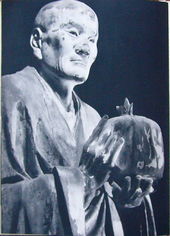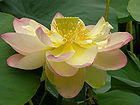- Asanga
-
Lands India • China • Japan
Vietnam • Korea
Singapore • Taiwan
Tibet • Bhutan • Nepal
Mongolia • United StatesDoctrine Bodhisattva • Śīla
Samādhi • Prajñā
Śunyatā • TrikāyaMahāyāna Sūtras Prajñāpāramitā Sūtras
Lotus Sūtra
Nirvāṇa Sūtra
Saṃdhinirmocana Sūtra
Avataṃsaka Sūtra
Śūraṅgama SūtraMahāyāna Schools Mādhyamaka
Yogācāra
Esoteric Buddhism
Pure Land • Zen
Tiantai • Nichiren
Asaṅga (Sanskrit: असङ्ग; Tibetan: ཐོགས་མེད།; Wylie: Thogs med; traditional Chinese: 無著; pinyin: Wúzhuó; Romaji: Mujaku) was a major exponent of the Yogācāra tradition in India, also called Vijñānavāda. Traditionally, he and his half-brother Vasubandhu are regarded as the founders of this school. The two half-brothers were also major exponents of Abhidharma teachings, which were highly technical and sophisticated hermeneutics as well.Contents
Early life
Asaṅga was born as the son of a Kshatriya father and Brahmin mother[1] in Purushapura (present day Peshawar in Pakistan), which at that time was part of the ancient kingdom of Gandhāra. Current scholarship places him in in the fourth century CE. He was perhaps originally a member of the Mahīśāsaka school or the Mūlasarvāstivāda school but later converted to Mahāyāna.[2]
In the record of his journeys through the kingdoms of India, Xuanzang wrote that Asaṅga was initially a Mahīśāsaka monk, but soon turned toward the Mahāyāna teachings.[3] Asaṅga had a half-brother, Vasubandhu, who was a monk from the Sarvāstivāda school. Vasubandhu is said to have taken up Mahāyāna Buddhism after meeting with Asaṅga and one of Asaṅga's disciples.[4]
Meditation and teachings
Asaṅga spent many years in intense meditation, during which time tradition says that he often visited Tuṣita Heaven to receive teachings from Maitreya Bodhisattva. Heavens such as Tuṣita Heaven are said to be accessible through meditation, and accounts of this are given in the writings of the Indian Buddhist monk Paramārtha, who lived during the 6th century CE.[5] Xuanzang tells a similar account of these events:[3]
“ In the great mango grove five or six li to the southwest of the city (Ayodhya), there is an old monastery where Asaṅga Bodhisattva received instructions and guided the common people. At night he went up to the place of Maitreya Bodhisattva in Tuṣita Heaven to learn the Yogācārabhūmi-śāstra, the Mahāyāna-sūtra-alaṃkāra-śāstra, the Madhyānta-vibhāga-śāstra, etc.; in the daytime, he lectured on the marvelous principles to a great audience. ” Asaṅga went on to write many of the key Yogācāra treatises such as the Yogācārabhūmi-śāstra, the Mahāyāna-samgraha and the Abhidharma-samuccaya as well as other works, although there are discrepancies between the Chinese and Tibetan traditions concerning which works are attributed to him and which to Maitreya.[6]
Abhidharma Samuccaya
According to Walpola Rahula, the thought of the Abhidharma-samuccaya is invariably closer to that of the Pali Nikayas than is that of the Theravadin Abhidhamma.[7]
Questions of authorship
The Tibetan tradition attributes authorship of the Ratnagotravibhaga to him, while the Chinese traditions attributes it to a certain Sthiramati or Sāramati. Peter Harvey finds the Tibetan attribution less plausible.[8]
References
- ^ Tsoṅ-kha-pa Blo-bzaṅ-grags-pa, Robert A. F. Thurman (Page 28)
- ^ 'Doctrinal Affiliation of the Buddhist Master Asanga' - Alex Wayman in Untying the Knots in Buddhism, ISBN 81-208-1321-9
- ^ a b Rongxi, Li. The Great Tang Dynasty Record of the Western Regions., Numata Center, Berkeley, 1996, p. 153.
- ^ Rongxi, Li. The Great Tang Dynasty Record of the Western Regions., Numata Center, Berkeley, 1996, pp. 154-155.
- ^ Wayman, Alex. Untying the Knots in Buddhism: Selected Essays. 1997. p. 213
- ^ On Some Aspects of the Doctrines of Maitreya (natha) and the Asanga - Giuseppe Tucci, Calcutta, 1930.
- ^ Dan Lusthaus, Buddhist Phenomenology. Routledge, 2002, page 44, note 5. Lusthaus draws attention to Rahula's Zen and the Taming of the Bull.
- ^ Peter Harvey, "An Introduction to Buddhism." Cambridge University Press, 1993, page 114.
External links
- Digital Dictionary of Buddhism (type in "guest" as userID)
- Vasubandhu: Entry at the Internet Encyclopedia of Philosophy
- Distinguishing Dharma and Dharmata by Asanga and Maitreya By: Thrangu Rinpoche
Categories:- 300 births
- 4th-century deaths
- 4th-century philosophers
- Buddhist philosophers
- Indian philosophers
- Indian Buddhists
Wikimedia Foundation. 2010.


